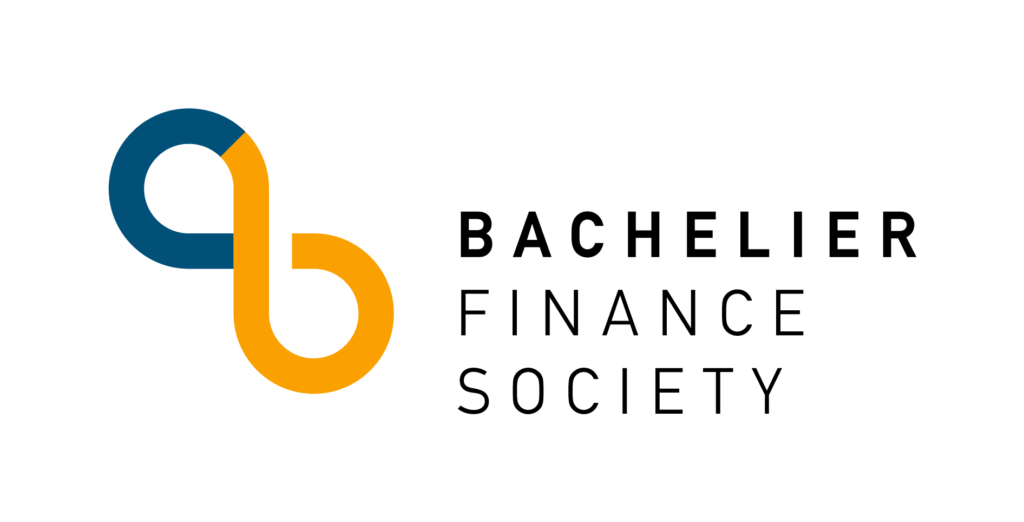Newsletter of the Bachelier Finance Society
Volume 9, Number 3, July 2017
NEW LOGO FOR THE BACHELIER FINANCE SOCIETY
As announced during the last BFS World Congress in New York, the society has a new logo. In the meantime, this has been integrated into the BFS website.

The use of the infinity symbol depicts the concept of limitless, borderless and complex thinking. Its cyclicality shows a constant state of re-thinking and re-creating. By supporting and positioning the infinity symbol diagonally, it highlights the initial b emerging from a complex concept, like revealing a hidden pattern.
JOB POSTINGS
The aim of these postings is to create a forum for the dissemination of information on academic and industrial positions related to mathematical finance, across different disciplines and different geographical regions. Please submit any job advertisements you are aware of to jobads@bachelierfinance.org, preferably in plain text and sending the link to the website containing all the information. Updates and new items appear continuously at: http://www.bachelierfinance.org/forum/jobs/.
Faculty Positions
University of Waterloo
Deadline: September 15, 2017
Professor
University of St. Thomas
Deadline: November 1, 2017
MOOCs in Mathematical Finance
Massive Online Open Courses (MOOCs) are a relatively new method for teaching and disseminating knowledge. The Bachelier Finance Society has started listing MOOCs related to mathematical finance on its webpage, see http://www.bachelierfinance.org/publications/moocs.html. Members are encouraged to send their MOOCs to the Administrative Director (office@bachelierfinance.org) or the Editors of the Newsletter if they want them included in this list.
We have also conducted a short Q&A with two colleagues who have recently created MOOCs related to mathematical finance, Jakša Cvitanić (JC) and Damir Filipović (DF), on the pros and cons of MOOCs.
Q&A on MOOCs
BOOKS & JOURNALS
The Society maintains a list of books, book reviews and journals at: http://www.bachelierfinance.org/publications.html. Members that would like to have their books added to the website, should please let us know.
Recently published books
Anna Aksamit, Monique Jeanblanc
Enlargement of Filtrations with Finance in View
Springer (2017), ISBN 978-3-319-41254-2
Pierre Henry-Labordère
Model-free Hedging: A Martingale Optimal Transport Viewpoint
Chapman & Hall/CRC (2017), ISBN 9781138062238
Maria Elvira Mancino, Maria Cristina Recchioni, Simona Sanfelici
Fourier-Malliavin Volatility Estimation: Theory and Practice
Springer (2017), ISBN 978-3-319-50969-3
ANNOUNCEMENTS
Call for Papers – The Canadian Journal of Statistics (CJS) will devote a special issue to the theme of “Stochastic Models, Statistics, and Finance.” The submission deadline is May 31, 2018. Please submit your paper through the CJS website, specifying that the submission is for the special issue: https://mc.manuscriptcentral.com/cjs-wiley.
BOOK REVIEW
Algorithmic and High-Frequency Trading
by Álvaro Cartea, Sebastian Jaimungal and José Penalva
Mathieu Rosenbaum, École Polytechnique
As the head of a masters program in quantitative finance, I am often asked the following question by students: what is a good textbook on the mathematics of trading algorithms?
I must say that I was never able to provide a really satisfactory answer. Thanks to Álvaro, Sebastian and José, now I can and I really thank them for that.
The book Algorithmic and High-Frequency Trading is published at a time where I believe the different aspects of market microstructure are quite well understood. However, probably no reference was properly summarizing the mathematics related to the design of trading algorithms. This book fills this gap and it was much needed. So I am convinced it will become a standard textbook very rapidly.
Beyond students, this work will also be very useful for academics looking for an overview of the mathematics of high frequency trading and for practitioners, who will find elements to build trading strategies and probably theoretical foundations for algorithms that they are already using.
The first part of the book is very accessible. It provides a summary of the basic elements of market microstructure: the way markets are operating in practice, a typology of market participants, a description of the main variables of interest and the most classical theoretical models. This part represents to me an excellent crash course on market microstructure.
Then the authors specialize on one particular topic of market microstructure: (optimal) algorithmic trading. To do so, they first need to introduce some mathematical concepts. This part (Part 2) is quite a tour de force. Indeed, in a few pages, the authors are able to explain the main ideas of stochastic control and optimal stopping. After reading this, one has already a sufficient knowledge of the technical concepts to deal with the sophisticated optimization problems occurring in practice. Of course one may say that the presentation is not completely rigorous. However, given the wide targeted audience for this book, this is in my opinion the right way to introduce such mathematical tools.
Equipped with the material of Part 2, the reader can now consider optimal trading problems which are relevant in practice. Starting from the classical setting of optimal execution, the authors describe in Part 3 a series of algorithmic trading problems and their solutions to them. In various contexts, they are able to answer the following high frequency related questions: When should I act on the market? Which type of orders should I use? What are the informative indicators? On which platform should I trade? As a market maker, what would be a good strategy for me? Of course no practitioner would probably directly apply the results here in her/his actual trading. However, such results should be seen as the theoretical foundations of the algorithms used in practice. What I find particularly amazing in this part is that the authors manage to never use cumbersome computations but still provide the main mathematical elements. Actually the reader gets the very pleasant feeling that all this is quite easy and that she/he would be able to use this machinery in many other situations. Another nice thing is the fact that this part also contains exercises.
Thus this book is very well balanced between market description, data analysis, theoretical mathematics, models and case studies. It focuses on the design of trading algorithms, which is nowadays a standard problem for many market participants. The writing and presentation are excellent. It should definitely be on the shelf of anybody interested in quantitative microstructure.
UPCOMING CONFERENCES
This list contains conferences related to mathematical finance that take place in the next three months. A full list is available at http://www.bachelierfinance.org/congresses/conferences.html. Please let us know of conferences we are not aware of and include a URL for the event.
21st International Congress on Insurance: Mathematics and Economics (IME 2017)
July 3–5, 2017
Vienna, Austria
International Workshop on BSDEs, SPDEs, and their Applications
July 3–7, 2017
Edinburgh, United Kingdom
AARMS 2017 Summer School
July 3–28, 2017
Charlottetown, Canada
Second Conference on the Mathematics of Energy Markets
July 4–6, 2017
Vienna, Austria
IME Educational Workshop
July 6–7, 2017
Vienna, Austria
Quant Summit USA
July 10–17, 2017
New York NY, USA
CASS London Summer School
July 10–28, 2017
London, United Kingdom
CEMRACS summer school 2017
July 17 – August 25, 2017
Marseille, France
Brazilian Finance Society meeting
July 20–22, 2017
Brasilia, Brazil
Mathematics in Finance
August 7–13, 2017
Kruger National Park, South Africa
Advanced Risk and Portfolio Management (ARPM) Bootcamp
August 14–19, 2017
New York NY, USA
10th European Summer School in Financial Mathematics
August 28 – September 1, 2017
Dresden, Germany
SIAM-LMS 2017 Conference on Mathematical Modeling in Finance
August 31 – September 2, 2017
London, United Kingdom
Stochastic Control, Ambiguity and Games
September 4–5, 2017
Leeds, United Kingdom
International Conference on Computational Finance (2nd Edition)
September 4–8, 2017
Lisbon, Portugal
Workshop on “Risk Measurement and Regulatory Issues in Business”
September 11–14, 2017
Montreal, Canada
Workshop on “Data science in Finance and Insurance”
September 15, 2017
Louvain-la-Neuve, Belgium
Measurement and control of systemic risk
September 25–28, 2017
Montreal, Canada
I Gran Sasso Workshop in Mathematical Finance
September 27–29, 2017
L’Aquila, Italy


Leave A Comment
You must be logged in to post a comment.